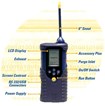Electronic Nose Offers Food Processors a Powerful New Smell Identification Tool

The first polymer composite sensor-based hand-held electronic nose was unveiled this week at PITTCON 2000 in New Orleans. The Cyranose 320, developed by Cyrano Sciences, rapidly senses off-odors associated with food manufacturing and packaging - detecting freshness, spoilage, contamination and batch-to-batch consistency.
"Food producers often use human sensory panels in the applications. The Cyrano Sciences technology represents a cost-effective method of improving these activities," said Richard Sill, vice president of sales & marketing for Cyrano Sciences, Inc. "Much like vision inspection is used in the electronics industry, olfactory inspection is ideally suited to the food industry."
Based on technology exclusively licensed from the California Institute of Technology, the Cyranose 320 offers a powerful, affordable and easy-to-use smell identification system. The sensor technology is based on conducting composites that change resistance with exposure to a vapor. Since each vapor is unique, each element of the array produces a different change in resistance. The pattern of resistance changes provides signature characteristics of the sample being measured. The device incorporates an easy-to-read graphic LCD with back lighting. Connection ports enable easy downloading of data into a user's spreadsheet package. Rapid response time, combined with easy one-button operation provides an effective and accurate measure of the vapors present. Standard, easily replaceable or rechargeable batteries supply power. Housed in a robust, water-resistant case, the portable electronic nose suits all environments.

The device can be trained to distinguish complex vapor mixtures as easily as simple vapors. It is designed to follow the simple process of training, sampling and reporting so that decisions can be made immediately without ever leaving the sample site. The user trains the 320 by exposing the sensor to each type of sample that will be encountered during testing. Careful selection of the types of samples must be made so that the full range of conditions is covered. After one training session the device can be used repeatedly without retraining. The sampling step involves placing the tip of the 320 snout near the sample and simply pressing run. The air reference, vapor sampling, sensor measurements and data processing are all handled automatically and take roughly one minute to complete. The unit then reports which type of sample in the training set is most closely like the present sample. The unit then automatically purges itself for a user-defined amount of time, typically a couple of minutes and the polymer composite sensors return to their original resistances.
The Cyranose 320 contains an array of 32 sensors, each of which consists of a pair of electrical contacts that are bridged by a composite film. Typically the film for each sensor is made of a composite of a nonconducting polymer and conductive carbon black particles. When the film absorbs vapor analytes and swells, the conductive pathways in the film are broken and the resistance of the composite film changes. The change in resistance between the electrical contacts is used as the output of the sensor. Since each sensor in the array contains a unique polymer, there will be a reproducible combination of resistances or "smellprint" for each vapor mixture. Polymers with a range of properties were chosen so that the sensor array could be used to distinguish many different types of vapors.
"Our goal to is digitize smell and make this information as ubiquitous as temperature measurements," said Steven Sunshine, president and CEO of Cyrano Sciences, Inc., "The Cyranose 320 represents the first in what will eventually be a family of web enabled devices that can provide simple chemical information."
For more information contact Cyrano Sciences, 73 N Vinedo Ave., Pasadena, CA 91107. Tel: 877-744-1700: Fax: 877-744-1777.
Edited by Pam Ahlberg
